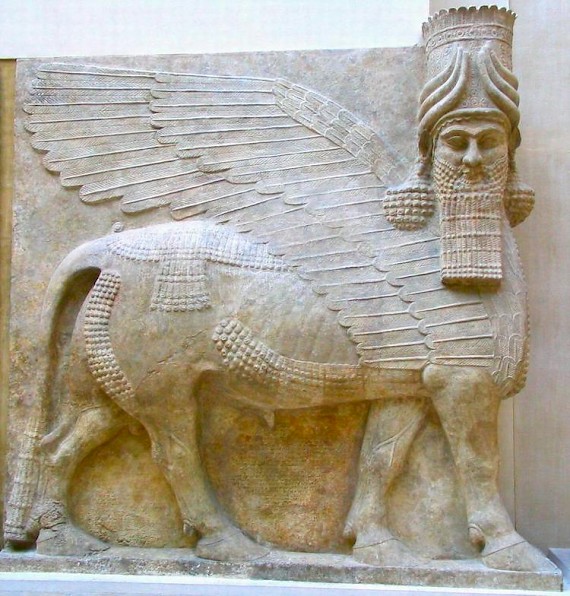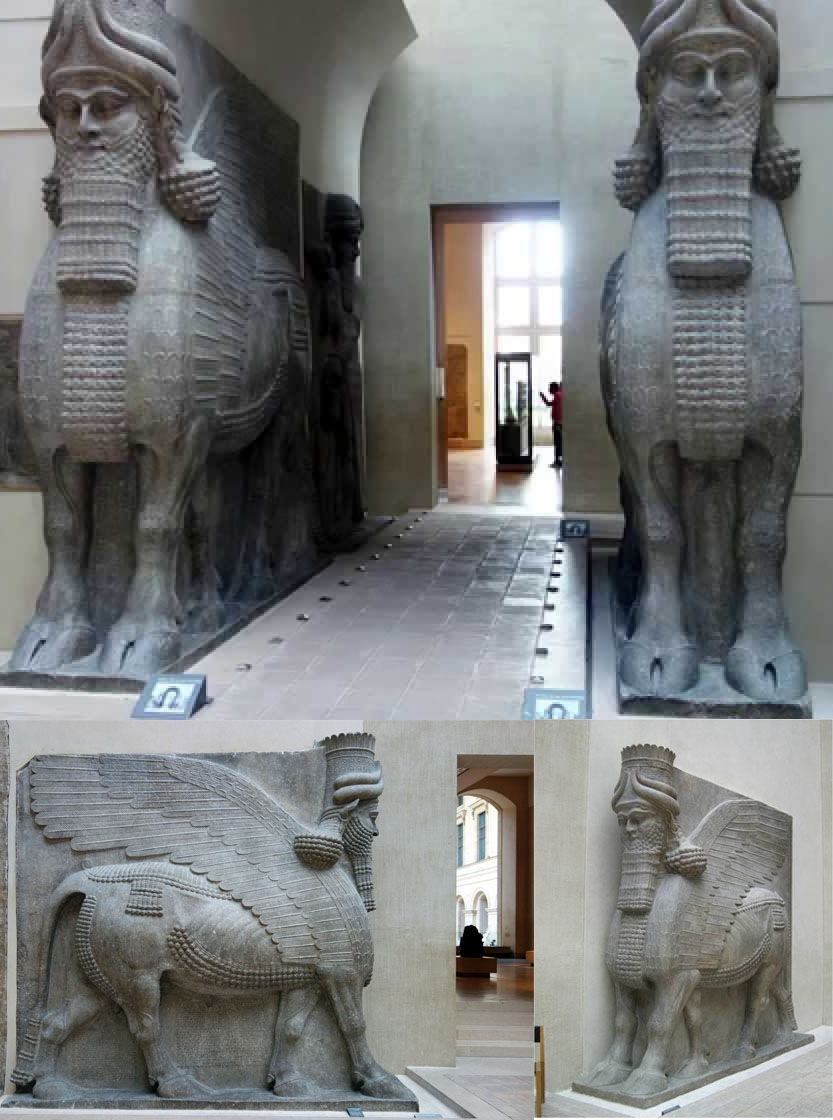
Lamassu (winged bullman) gateway from the Palace of Sargon II at Khorsabad (DurSharrukin
This colossal sculpture of a winged-bull was one of a series that guarded the entrance to the throne room of Sargon II, king of Assyria (721-705 BC), in his palace at Khorsabad, the capital city of the Neo-Assyrian Empire during his reign.This figure, known as a lamassu from the textual sources, is a composite mythological being with the head of a human, the body and ears of a bull, and the.

Assyrian Lamassu Winged Bull Statue, 10 Inches Cultural Elements
Overview Provenance References Title: Human-headed winged bull (lamassu) Period: Neo-Assyrian Date: ca. 883-859 BCE Geography: Mesopotamia, Nimrud (ancient Kalhu) Culture: Assyrian Medium: Gypsum alabaster Dimensions: H. 123 1/2 x W. 26 1/2 x D. 122 in., 15999.8 lb. (313.7 x 67.3 x 309.9 cm, 7257.4 kg)

Assyrian Lamassu Winged Bull Statue, 10 Inches
Iraqi security forces stand guard at the site of a newly-unearthed Assyrian lamassu (human-headed winged bull) sculpture discovered with its entire wings intact by the French archaeological mission at the archaeological site of Khorsabad (also known as Dur-Sharrukin), the former Assyrian capital in the time of Sargon II (721-705 BCE) in Iraq's northern Nineveh province on Oct. 24, 2023.

Lamassu (bullman) Livius
BBC News One year ago a man took a pneumatic drill to the statue of a winged bull at the gates of the ancient city of Nineveh, near Mosul in modern Iraq. It's one of countless treasures.

Assyrian Lamassu Winged Bull Statue, 10 Inches Statue, Ancient aliens, Ancient civilizations
The newly re-excavated 2,700-year-old lamassu—a winged bull with a human head—at the site of the ancent city of Dur-Sharrukin in northern Iraq Zaid Al-Obeidi / AFP via Getty Images

Historical Assyrian Lamassu winged Bull wall Sculpture Etsy Italia
Lama, Lamma, or Lamassu ( Cuneiform: 𒀭𒆗, an.kal; Sumerian: d lammař; later in Akkadian: lamassu; sometimes called a lamassus) [1] [2] is an Assyrian protective deity. [3] Lamma, protective winged deity, Sumerian Isin-Larsa period (2000-1800 BC) Lamassu, Neo-Assyrian Empire, c. 721-705 BC

Lamassu, statue of a winged bull with a human face, Assurnasirpal... News Photo Getty Images
This Human-Headed Winged Bull is a Lamassu, which is an Assyrian protective deity, often depicted as having a human head, the body of a bull or a lion, and bird wings. The horned cap attests to its divinity, and the motif of a winged animal with a human head is common to the Near East.

Mythology Ancient Large Lifesize Bronze Lamassu Winged Bull Statue
A dig in northern Iraq has unearthed a 2,700-year-old alabaster sculpture of the winged Assyrian deity Lamassu, which was found largely intact despite its large dimensions. (Zaid AL-Obeidi / AFP) READ: https://t.co/p2FvR6Okjh pic.twitter.com/tHTeJfzs9L — PhilSTAR L!fe (@philstarlife) October 28, 2023 The Lamassu

Winged humanheaded bull statue known as a Lamassu or 'Protective spirit'. Assyrian, (circa 865
Winged human-headed bull (lamassu or shedu), 721-705 B.C.E. (reign of Sargon II, Neo-Assyrian Period, Khorsabad, ancient Dur Sharrukin, Assyria, Iraq), gypseous alabaster, 4.20 x 4.36 x 0.97 m, excavated by P.-E. Botta 1843-44 (Musée du Louvre, Paris; photo: Steven Zucker, CC BY-NC-SA 2.0)

Lamassu from the citadel of Sargon II, Dur Sharrukin, Winged humanheaded bull (lamassu or shedu
Lamassu are human-headed, eagle-winged, bulls or lions that once protected cities in Mesopotamia. They were believed to be very powerful creatures, and served both as a clear reminder of the king's ultimate authority and as symbols of protection for all people.

Humanheaded winged bull and winged lion (lamassu) Work of Art Heilbrunn Timeline of Art
The 2700-year-old alabaster statue depicting the winged Assyrian deity Lamassu was found in northern Iraq on October 24, AFP reports, in almost one piece. The massive sculpture was almost entirely intact when it was unearthed at the archaeological site of Khorsabad. Picture: Zaid Al-Obeidi / AFP.

"Historical Assyrian Lamassu winged Bull wall Sculpture 10\" Mesopotamia SIZE 10
The body of the Winged Bull Lamassu, unearthed at the Khorsibad archaeological site in Nineveh, Iraq. An Exciting New Discovery in Mesopotamia: The Resurrection of the Winged Bull Lamassu November 1, 2023 A recent discovery in Mesopotamia has set the archaeological world abuzz.

Lamassu Winged Human Head Bull, Louvre Museum Editorial Photo Image of artifact, gypsum
Winged human-headed bull (lamassu or shedu), 721-705 B.C.E. (reign of Sargon II, Neo-Assyrian Period, Khorsabad, ancient Dur Sharrukin, Assyria, Iraq), gypseous alabaster, 4.20 x 4.36 x 0.97 m, excavated by P.-E. Botta 1843-44 (Musée du Louvre, Paris; photo: Steven Zucker, CC BY-NC-SA 2.0)

OIM Lamassu
Lamassu: Babylonian protective demon with a bull's body, eagle's wings, and a human head. The name lamassu is not without problems. The Sumerian word lama, which is rendered in Akkadian as lamassu, refers to a protective deity, who is usually female. She is often represented as a standing figure that introduces guests to another, superior god.

Archaeological Photography on Instagram “📌 Assyrian Lamassu (humanheaded winged bull) in
Title: Human-headed winged lion (lamassu) Period: Neo-Assyrian Date: ca. 883-859 BCE Geography: Mesopotamia, Nimrud (ancient Kalhu) Culture: Assyrian Medium: Gypsum alabaster

Lamassu from Khrsabad at the Iraq Museum (Illustration) Ancient History Encyclopedia
Human-Headed Winged Bull. This colossal sculpture was one of a pair that guarded the entrance to the throne room of King Sargon II. A protective spirit known as a "lamassu", it is shown as a composite being with the head of a human, the body and ears of a bull, and the wings of a bird. Viewed from the side, the creature appears to be walking.